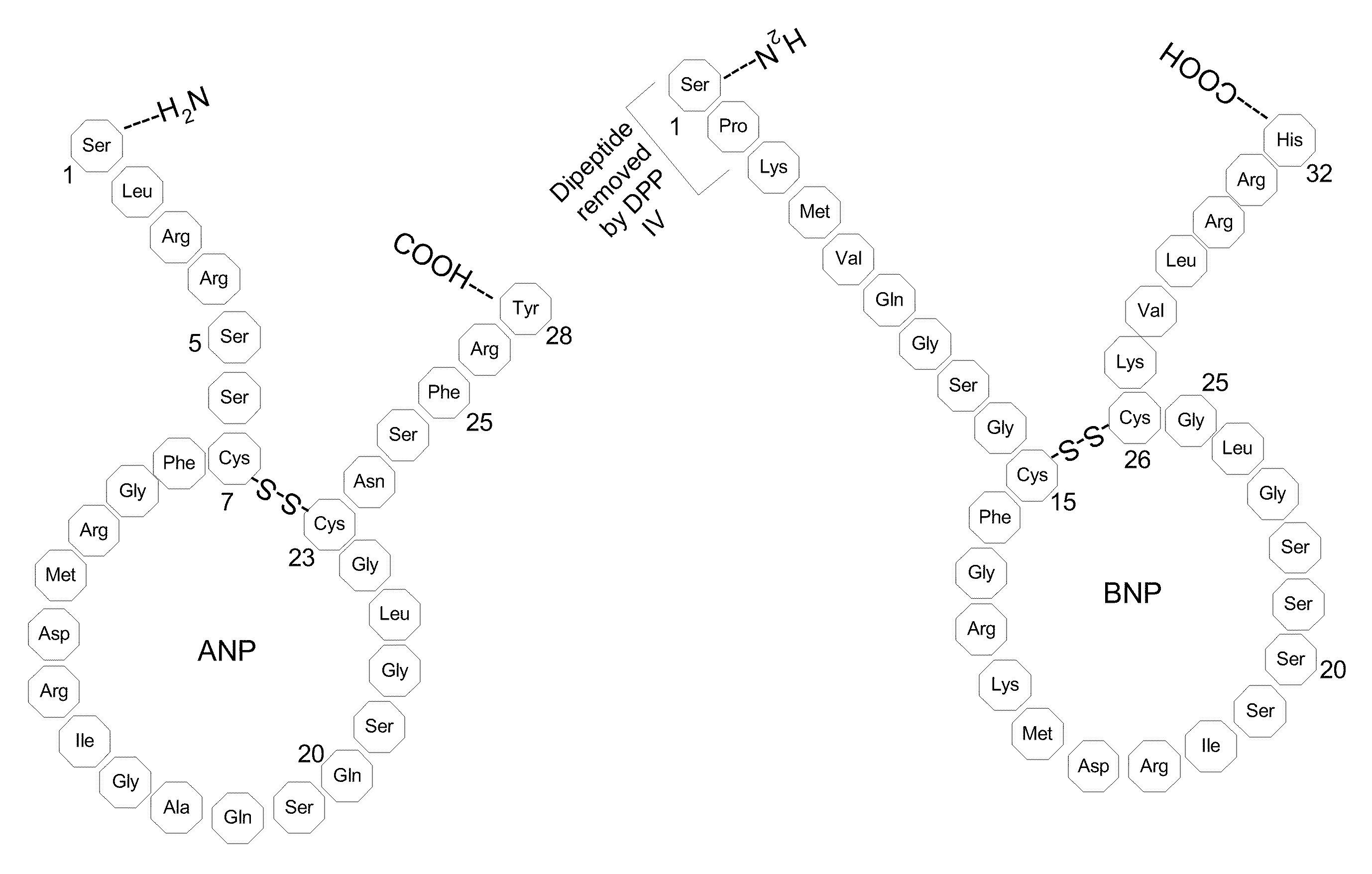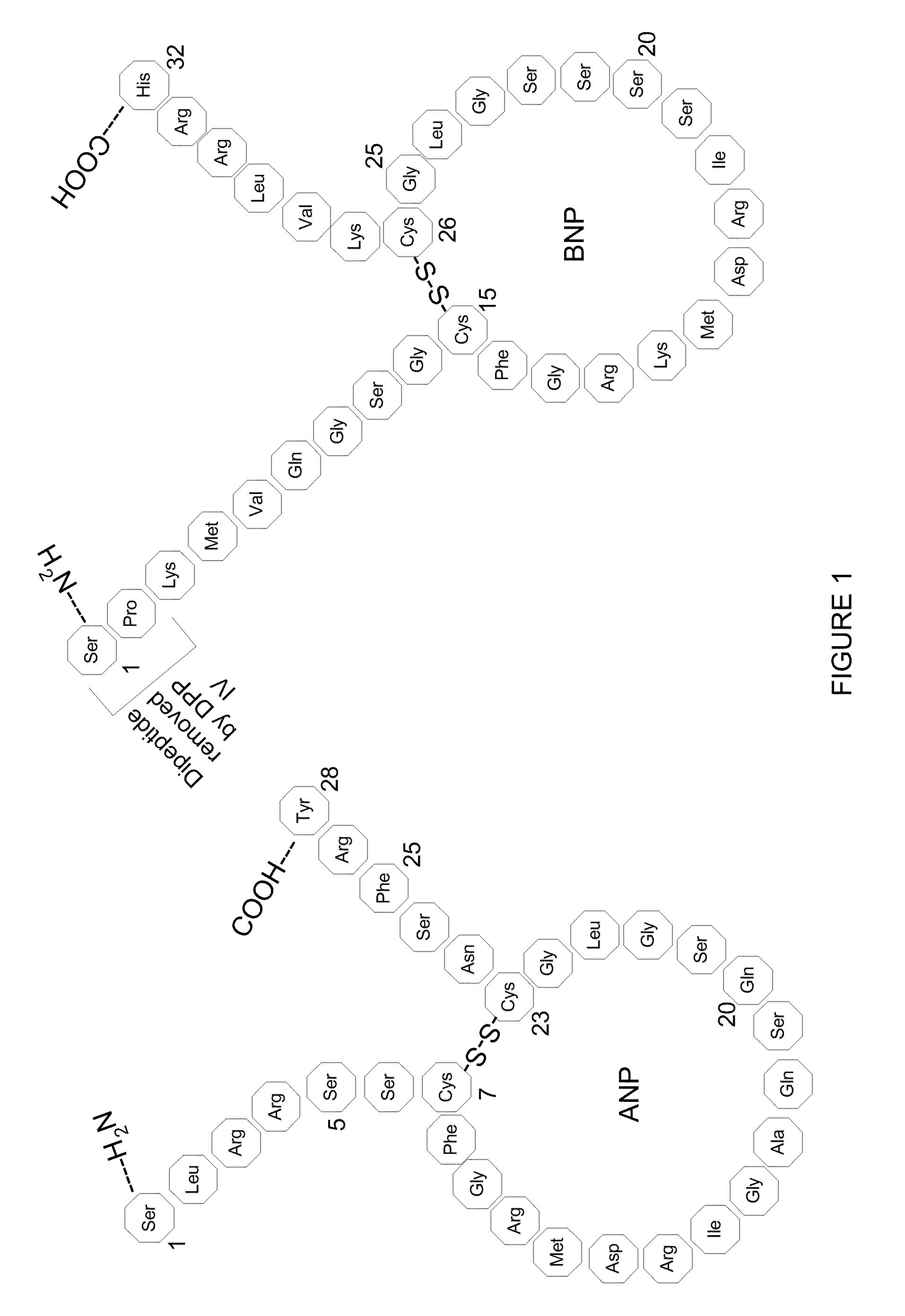Method, composition and device for sampling natriuretic peptides in a biological fluid
a biological fluid and peptide technology, applied in chemical methods analysis, instruments, suspensions and porous materials analysis, etc., to achieve the effect of convenient manufacture and easy manufacturing
- Summary
- Abstract
- Description
- Claims
- Application Information
AI Technical Summary
Benefits of technology
Problems solved by technology
Method used
Image
Examples
example 1
[0076]In order to observe, characterize and identify the BNP hydrolysis products a Mass Spectrometric Immunoassay (MSIA) was developed and employed in the analysis of BNP. This technique is broadly described in, e.g., Nelson et al. (1995) Anal. Chem. 67, 1153-1158; Tubbs et al. (2001) Anal. Biochem. 289, 26-35; Kiernan et al. (2002) Anal. Biochem. 301, 49-56; Niederkofler et al. (2003) J. Lipid Res. 44, 630-639 and U.S. Pat. Nos. 6,783,672; 6,974,704; 7,083,723; 7,083,724; 7,087,163; 7,087,164; 7,087,165; and 7,087,163. The basic methodology is described in the context of BNP although the technique is also applicable to ANP and other peptides of interest.
[0077]Briefly, MSIA entails the use of affinity capture, to extract BNP and many of its' hydrolysis products for mass spectrometric detection, to observe and identify products of BNP hydrolysis. Therefore, synthesized BNP1-32 was added to room temperature plasma (from blood collected in heparinized blood collection tubes). At a seve...
example 2
[0080]Studies to identify protease inhibitors able to prevent BNP1-32 hydrolysis began with screening. First tested was the protease inhibitor cocktails used in the Becton Dikinson collection tubes (BD P100 v.1.1 tubes).
[0081]Commercially available protease inhibitor cocktail in the BD P100 v1.1 blood collection vacuum tubes (Becton, Dickinson, and Company catalog no. 8013142) was tested for arresting the hydrolysis of BNP. Shown in FIG. 4 are the illustrative results of sequentially analyzing samples from plasma that was provided from blood collected using BD P100 v1.1 and spiked with BNP1-32. Observed in each of the mass spectra are two species of BNP, the intact form of BNP1-32 and the truncated BNP form of BNP3-32 due to hydrolysis of BNP1-32. The plot of percentage of BNP species over time shows that after only 30 minutes half of the BNP1-32 has been converted into BNP3-32, demonstrating the inability of the protease inhibitors provided by the BD P100 to prevent the hydrolysis ...
example 3
[0082]Another commercially available cocktail of protease inhibitors tested was the protease inhibitor cocktail set III (diluted 1 to 10 in plasma) provided by EMD (catalog no. 535140). Once again, heparin plasma was treated with this protease inhibitor cocktail set followed by the addition of BNP1-32 and incubation at room temperature. Aliquots were collected every 30 to 60 minutes and tested for BNP hydrolysis. The results of the mass spectral analyses of the aliquots, as well as the plot of the percentage of BNP species over time are shown in FIG. 5. Observed is that protease inhibitor cocktail set III prevents or slows the hydrolysis of BNP1-32, but in addition to preventing the hydrolysis of BNP, the protease inhibitor cocktail results in adduct formation, which adducts are indicated by the peaks located at a slightly higher mass than the BNP1-32. The extent of adduct formation increases significantly with incubation time.
[0083]Protease inhibitor cocktail set III consists of 10...
PUM
| Property | Measurement | Unit |
|---|---|---|
| temperature | aaaaa | aaaaa |
| temperature | aaaaa | aaaaa |
| temperature | aaaaa | aaaaa |
Abstract
Description
Claims
Application Information
 Login to View More
Login to View More - R&D
- Intellectual Property
- Life Sciences
- Materials
- Tech Scout
- Unparalleled Data Quality
- Higher Quality Content
- 60% Fewer Hallucinations
Browse by: Latest US Patents, China's latest patents, Technical Efficacy Thesaurus, Application Domain, Technology Topic, Popular Technical Reports.
© 2025 PatSnap. All rights reserved.Legal|Privacy policy|Modern Slavery Act Transparency Statement|Sitemap|About US| Contact US: help@patsnap.com



